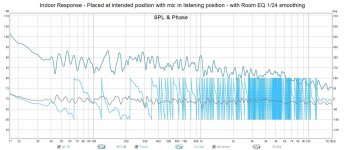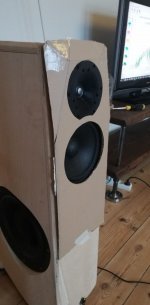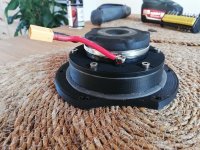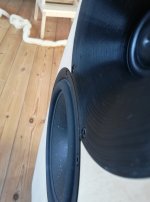Excellent design, construction and measured performance!
There is shallow on-axis dip around 2-5kHz which is not fully compensated by off-axis. Is that because of voicing the speaker in the room? I have noticed that ears are very sensitive to that kind of low Q 2dB swings around that range.
Do you have in-room measurements at the spot, psychoacoustic smoothing, RTA or MMM style per each speaker? Can you also show the RT60?
There is shallow on-axis dip around 2-5kHz which is not fully compensated by off-axis. Is that because of voicing the speaker in the room? I have noticed that ears are very sensitive to that kind of low Q 2dB swings around that range.
Do you have in-room measurements at the spot, psychoacoustic smoothing, RTA or MMM style per each speaker? Can you also show the RT60?
Well, I just have to say once again - very, very well  done.
done. 

You should be extremely proud of yourself I think, both for the beautiful pieces of art that you have created as well as what looks to be the outstanding quality of sound that you have achieved. Your ears have some serious happy time to look forward to......

PS. Maybe for anyone following along, you may want to talk just a little bit more about your change of tweeter and addition of a waveguide?


You should be extremely proud of yourself I think, both for the beautiful pieces of art that you have created as well as what looks to be the outstanding quality of sound that you have achieved. Your ears have some serious happy time to look forward to......

PS. Maybe for anyone following along, you may want to talk just a little bit more about your change of tweeter and addition of a waveguide?
Hello again you three! 
Thanks alot for the fine words!!

I am also VERY happy with the result! it even exceeded my expectations!
Juhazi#
The dip is caused by the Harsch crossover typology. If I use LR filters with the exact same driver EQ I get a ruler flat response. Here you can see the individual drivers compared to their target curves for the Harsch filter (and LR24 down low).

The Harsch "swing" can be adjusted by timing of the two drivers, but this was my preferred result. I rather want a slight dip than any kind of bump! I am NOT a fan of bright sounding speakers. So yes my speaker sound warm, but it still has clear vocals and details. That's how I like it
Right now I only have this measurement. This is done with speaker at position L (on image in page 12) and microphone in the middle of the couch (position 2).

I am very happy with that. The low end drastically falls of from 15 Hz (if I can even trust my mic down there). I love the rise down low, you don't notice it for most music but sure does in movies and games, you FEEL it. And that was exactly what i wanted
Thanks alot for the fine words!!
I am also VERY happy with the result! it even exceeded my expectations!
Juhazi#
The dip is caused by the Harsch crossover typology. If I use LR filters with the exact same driver EQ I get a ruler flat response. Here you can see the individual drivers compared to their target curves for the Harsch filter (and LR24 down low).
The Harsch "swing" can be adjusted by timing of the two drivers, but this was my preferred result. I rather want a slight dip than any kind of bump! I am NOT a fan of bright sounding speakers. So yes my speaker sound warm, but it still has clear vocals and details. That's how I like it
Right now I only have this measurement. This is done with speaker at position L (on image in page 12) and microphone in the middle of the couch (position 2).
I am very happy with that. The low end drastically falls of from 15 Hz (if I can even trust my mic down there). I love the rise down low, you don't notice it for most music but sure does in movies and games, you FEEL it. And that was exactly what i wanted
Attachments
By the way, Does anyone know what causes the peak at 50 Hz on the tweeter and midrange measurement above?
At first i thought it was something in my apartment that i couldn't hear, but now i see it is also outside. It appears with and without charger in the laptop. Regardles of USB cable and USB port.. Regardless of JAVA drivers or ASIO drivers...
WHAT IS IT?
PS: in Denmark all mains power are 50 Hz, thats why i suspected the charger..
At first i thought it was something in my apartment that i couldn't hear, but now i see it is also outside. It appears with and without charger in the laptop. Regardles of USB cable and USB port.. Regardless of JAVA drivers or ASIO drivers...
WHAT IS IT?
PS: in Denmark all mains power are 50 Hz, thats why i suspected the charger..
jReave#
Thanks again!
Sorry about that, I was sure I already posted about the WG.
So the story goes:
No matter what I did with the filter I never liked the sound of my MW19 + R3004 combo. The MW19 need to be crossed low due to its breakup. The R3004 does NOT like to be crossed low. I tried 1800-2000 Hz but it always got irritating and harsch already at moderate listening levels.
In short - I was NOT happy..
Someone (not mentioning any names .. Rocky!) got me super interested in waveguides all of a sudden.. While being frustrated over my tweeter performance I decided to play around with waveguides for the R3004. I designed, 3D printed and tested 6 different geometries before I landed on something that measured really well! The good thing about this was that it boosted the range of the tweeter where it was struggling. This is what it looked like:

(Weee cardboard.. like you told me to xD)
I could definitely hear a difference! I was intrigued! But still not happy..
While playing around with my R3004 I heard someone elses speaker.. (Rocky xD) and imideately fell in love with the combination of a SB SATORI midwoofer (he uses the MW16) and the SATORI TW29RN tweeter..
So still not satisfied by my own setup compared to his, I simply had to try this tweeter.
Having already discovered the benefits of WG's in a small room like mine I didn't even bother to experiment a whole lot with the tweeter on it's own - I heard it in his, I loved it, but.. could it be better!?
So I used what I learned from the R3004 WG's and in my second try I had the WG shown in the previous post.
The WG it self is the largest I could possibly fit in my cabinet. Since I didn't plan on a WG the tweeter chamber is not very big, so the depth of the WG couldn't be so deep and the faceplate of the tweeter was an issue.. Not something a router couldn't fix though
Anyway I realized that the depth was not the limiting factor with classic hyperbolic WG's - it was the diameter. However, I use a different profile and am now maxed out on both depth and diameter for my cabinet. Luckily this is, as you can see, enough to match the MW19 perfectly!
The WG uses the tweeter as is, no need for disassembly or anything.

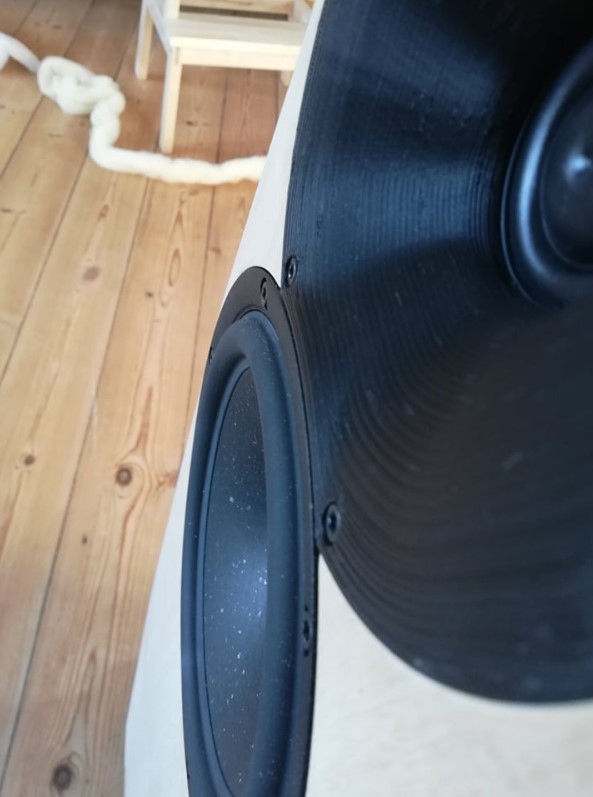
So that was the WG story in short.. Any questions? xD
Thanks again!
Sorry about that, I was sure I already posted about the WG.
So the story goes:
No matter what I did with the filter I never liked the sound of my MW19 + R3004 combo. The MW19 need to be crossed low due to its breakup. The R3004 does NOT like to be crossed low. I tried 1800-2000 Hz but it always got irritating and harsch already at moderate listening levels.
In short - I was NOT happy..
Someone (not mentioning any names .. Rocky!) got me super interested in waveguides all of a sudden.. While being frustrated over my tweeter performance I decided to play around with waveguides for the R3004. I designed, 3D printed and tested 6 different geometries before I landed on something that measured really well! The good thing about this was that it boosted the range of the tweeter where it was struggling. This is what it looked like:
(Weee cardboard.. like you told me to xD)
I could definitely hear a difference! I was intrigued! But still not happy..
While playing around with my R3004 I heard someone elses speaker.. (Rocky xD) and imideately fell in love with the combination of a SB SATORI midwoofer (he uses the MW16) and the SATORI TW29RN tweeter..
So still not satisfied by my own setup compared to his, I simply had to try this tweeter.
Having already discovered the benefits of WG's in a small room like mine I didn't even bother to experiment a whole lot with the tweeter on it's own - I heard it in his, I loved it, but.. could it be better!?
So I used what I learned from the R3004 WG's and in my second try I had the WG shown in the previous post.
The WG it self is the largest I could possibly fit in my cabinet. Since I didn't plan on a WG the tweeter chamber is not very big, so the depth of the WG couldn't be so deep and the faceplate of the tweeter was an issue.. Not something a router couldn't fix though
Anyway I realized that the depth was not the limiting factor with classic hyperbolic WG's - it was the diameter. However, I use a different profile and am now maxed out on both depth and diameter for my cabinet. Luckily this is, as you can see, enough to match the MW19 perfectly!
The WG uses the tweeter as is, no need for disassembly or anything.
So that was the WG story in short.. Any questions? xD
Attachments
Wow, nice little beefy speakers you have built! Your woodworking is really great!
I've learned a lot on this thread about how to set up the fusion amps and properly design a crossover, thanks.
I'm building a much simpler satori-scan speak 3 way:
https://www.diyaudio.com/forums/multi-way/333956-3-studio-monitor-design-7.html#post6232908
almost finished the second speaker and I'm working on the crossover at the moment ;-)
I've learned a lot on this thread about how to set up the fusion amps and properly design a crossover, thanks.
I'm building a much simpler satori-scan speak 3 way:
https://www.diyaudio.com/forums/multi-way/333956-3-studio-monitor-design-7.html#post6232908
almost finished the second speaker and I'm working on the crossover at the moment ;-)
- Status
- This old topic is closed. If you want to reopen this topic, contact a moderator using the "Report Post" button.
- Home
- Loudspeakers
- Multi-Way
- Small active 3-way floor stander with a punch

